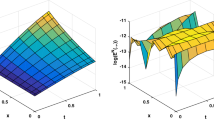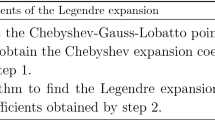Abstract
In this article, we implement a spectral collocation method by using the properties of Legendre and Lagrange polynomials for solving the resulting nonlinear system of ODEs of the biochemical reaction model. This technique reduces the proposed model to a system of algebraic equations. We prove the uniqueness and present the local stability of the given model. A comparison with the numerical solution is obtained by using the RK4 method and the previously published results using the Picard-Padè method. The proposed method introduces a promising tool for solving many nonlinear systems of differential equations. Numerical illustrations are stated to demonstrate utility, validity and the great potential of the introduced method.



Similar content being viewed by others
References
Bell, W.W.: Special Functions for Scientists and Engineers. Great Britain, Butler and Tanner Ltd, Frome (1968)
Borhanifara, A., Khader, M.M.: Jacobi operational matrix and its application for solving systems of ODEs. Differ. Equ. Dyn. Syst. 24(4), 459–473 (2015)
Butcher, J.C.: Numerical Methods for Ordinary Differential Equations. Wiley, New York (2003)
Goha, S.M., Noorani, M.S.M., Hashim, I.: Introducing variational iteration method to a biochemical reaction model. Nonlinear Anal. Real World Appl. 11, 2264–2272 (2010)
Hashim, I., Chowdhurly, M.S.H., Mawa, S.: On multistage homotopy perturbation method applied to nonlinear biochemical reaction model. Chaos Solitons Fract. 36, 823–827 (2008)
Khader, M.M.: On the numerical solutions to nonlinear biochemical reaction model using Picard–Padé technique. World J. Model. Simul. 9(1), 38–46 (2013)
Khader, M.M.: Numerical treatment for solving fractional logistic differential equation. Differ. Equ. Dyn. Syst. 24(1), 99–107 (2016)
Kumar, R., Kumar, S.: A new fractional modelling on susceptible-infected-recovered equations with constant vaccination rate. Nonlinear Eng. 3(1), 11–19 (2013)
Lin, W.: Global existence theory and chaos control of fractional differential equations. J. Math. Anal. Appl. 332, 709–726 (2007)
Matignon, D.: Stability results for fractional differential equations with applications to control processing. Computational engineering in systems and application. In: Multiconference, IMACS, IEEE-SMC, Lille, France, vol. 2, pp. 963–968 (1996)
Odibat, Z.M., Shawagfeh, N.T.: Generalized Taylor’s formula. Appl. Math. Comput. 186, 286–293 (2007)
Schnell, S., Mendoza, C.: Closed form solution for time-dependent enzyme kinetics. J. Theor. Biol. 187, 207–212 (1997)
Sen, A.K.: An application of the Adomian decomposition method to the transient behavior of a model biochemical reaction. J. Math. Anal. Appl. 131, 232–245 (1998)
Acknowledgements
The author thanks Deanship of Academic Research, Al Imam Mohammad Ibn Saud Islamic University (IMSIU), Riyadh, KSA, for the Financial support of the project number (371204).
Author information
Authors and Affiliations
Corresponding author
Additional information
Publisher's Note
Springer Nature remains neutral with regard to jurisdictional claims in published maps and institutional affiliations.
Rights and permissions
About this article
Cite this article
Khader, M.M. Numerical Treatment by Using a Hybrid Efficient Technique for the Biochemical Reaction Model. Differ Equ Dyn Syst 28, 707–713 (2020). https://doi.org/10.1007/s12591-019-00455-1
Published:
Issue Date:
DOI: https://doi.org/10.1007/s12591-019-00455-1
Keywords
- Biochemical reaction model
- Spectral collocation method
- Legendre–Lagrange
- Polynomials
- RK4 method
- Stability analysis




